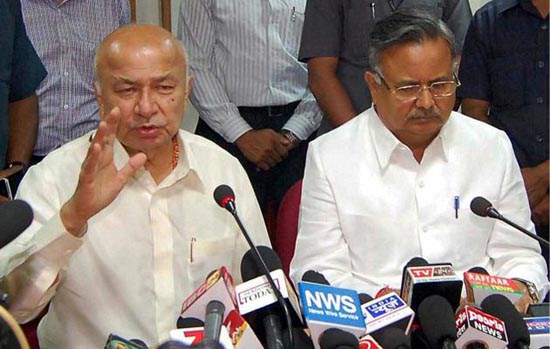Union Home Minister Sushil Kumar Shinde’s comment that the Central and State governments were going to undertake a ‘joint operation’ against Maoists in Chhattisgarh has confused officers at the ground level as such operations are always performed in collaboration anyway.
Mr. Shinde’s statement came after an hour-long meeting with Chief Minister Raman Singh, senior ministers and bureaucrats here on Friday to discuss measures in the aftermath of Saturday’s Maoist attack on a Congress convoy in Darbha near here.
For years, the operations against the red rebels in Bastar have been jointly conducted, sources told The Hindu.
“Chief Minister Raman Singh told me that this time we will not put any demand [to the Centre] except we want support. Central forces will support the State in the joint operation,” said Mr. Shinde.
Chhattisgarh police almost always move with the Central paramilitary, such as the Central Reserve Police Force or the Border Security Force, in Bastar. In the bordering areas, it coordinates with anti-Maoist elite forces, such as Greyhound on the Andhra Pradesh border and C60 on the Maharastra border. As many as three forces move together at times.
For instance, it was Greyhound that led the operation at Puwarthy in Bijapur district a few weeks back, wiping out the top leadership of one of the Maoist divisions of North Telangana Special Zonal Committee.
The operation in Pidiya, where nine civilians were killed, was led by the CRPF with the State police contributing about one-third of the force. “Are these not joint actions?” ask police officials.
In a number of areas the police and paramilitary camps are adjacent to each other. The top management of the paramilitary forces coordinate closely before, during and after any operation. However, in an interview to The Hindu earlier this week, Mr. Singh had said a national-level “integration plan” was required to control Maoism. “Perhaps, he is talking about that integration plan, more coordinated approach,” said an officer.
Judicial inquiry
Regarding the allegations about intelligence failure, Mr. Shinde said everything would come out through a proper inquiry. “If it is an intelligence failure or conspiracy, we will come to know about that after the two ongoing inquiries,” he said. A judicial inquiry was ordered by the State government within 48 hours of the incident. A team of the National Investigation Agency (NIA) too is stationed in Jagdalpur for a thorough probe, assisted by the State police and Central agencies.
Mr. Shinde suggested developing a special anti-Maoist force like the Greyhound to combat Maoism. “Every Naxal-affected State should develop a Greyhound force [on the lines of Andhra Pradesh] to combat Naxals. The Centre would offer help in this area,” he said.
“Terror attack”
Calling Saturday’s ambush on the Congress convoy a “terror attack”, Mr. Shinde said: “So far we were thinking that this [violence] would be some [sort of] movement. But in the 2010 incident [in Tadmetla, where 76 security personnel were killed] and the May 25 one, we have seen it is nothing other than terror,” he said.
Earlier on Friday, Mr. Shinde visited the family members of Mr. Patel at his native Nadeli village in Raigarh district.
Meanwhile, a half squad of the Maoists attacked and injured an ex leader of anti-Maoist movement Salwa Judum on Friday. 40-year-old Madvi Bhorasu was stabbed in the weekly bazaar at Bhairamgarh, near Bijapur, police sources confirmed. Maoists have also sent a letter to the Sukma Collector and issued threats to kill as many as 15 SJ leaders and activists. The letter demanded pulling out troops from Bastar and halting political rallies and Operation Green Hunt.
As many as 10-15 paramilitary companies have entered various districts of Bastar and begun combing operations, with almost half the force coming from the State police. While the officers are tight-lipped about the operation, sources told The Hindu that more than 2,000 security personnel had entered Bastar.

